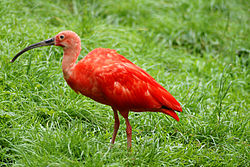

The South American Classification Committee (SACC) of the American Ornithological Society lists 489 species of birds that have been confirmed on the islands of Trinidad and Tobago as of July 2024. Of them, two are endemic, seven have been introduced by humans, 131 are rare or vagrants, 11 have been extirpated, and the status of one is not known.[1][2] The origin of one species (vagrant or introduced) is uncertain.[3] As of November 2023 the Trinidad & Tobago Bird Status & Distribution Committee (BSDC) did not recognize three of them and had added six, all of them vagrants.[4][5]
There are few places in the world where so many bird species can be seen in such a small area, many of them unique, very rare, or of particular interest. They range from the many species of hummingbird to the cave-dwelling oilbird (which uses echo-location to fly in the dark) and the scarlet ibis.
The islands are within a few miles of Venezuela, and the species are therefore typical of tropical South America. However, the number of species is relatively low compared to the mainland, as would be expected on small islands. The resident breeding birds are augmented in the northern winter by migrants from North America, although the variety of migrant passerines is very limited compared to Central America.[citation needed]
Unless noted otherwise, the list of species is that of the SACC with distribution notes by the BSDC.[1][4][5] The list's taxonomic treatment (sequence of orders, families, and species) and nomenclature (common and scientific names) are also those of the SACC.[6]
Species in the list are common on both main islands except as indicated otherwise. Many are also present on other, small, islands which are usually not named in the list. Tobago has only about half the number of bird species of Trinidad, but several species and subspecies have occurred only on the smaller island. Some of the smaller islands off Tobago, such as Little Tobago, have important seabird breeding colonies.[1][4][5]
- ^ a b c Kenefick, Martyn (22 September 2020). "Species lists of birds for South American countries and territories: Trinidad and Tobago". South American Classification Committee of the American Ornithological Society. Retrieved 28 July 2024.
- ^ Remsen, J. V., Jr., J. I. Areta, E. Bonaccorso, S. Claramunt, G. Del-Rio, A. Jaramillo, D. F. Lane, M. B. Robbins, F. G. Stiles, and K. J. Zimmer. Version 27 July 2024. Species Lists of Birds for South American Countries and Territories. https://www.museum.lsu.edu/~Remsen/SACCCountryLists.htm retrieved July 28, 2024
- ^ "Red-and-green Macaw Page". Southeastern Caribbean Birds - Photo Gallery. Trinidad and Tobago Field Naturalists' Club, Trinidad & Tobago Bird Status & Distribution Committee. 27 February 2001. Retrieved 15 April 2023.
- ^ a b c "Official checklist of Trinidad & Tobago" (PDF). Trinidad & Tobago Bird Status & Distribution Committee. December 2021. Retrieved 27 November 2023.
- ^ a b c Kenefick, Martyn; et al. (26 December 2021). "Reports and Publications". Trinidad & Tobago Bird Status & Distribution Committee. Retrieved 27 November 2023.
- ^ Remsen, J. V., Jr., J. I. Areta, E. Bonaccorso, S. Claramunt, G. Del-Rio, A. Jaramillo, D. F. Lane, M. B. Robbins, F. G. Stiles, and K. J. Zimmer. Version 27 July 2024. A classification of the bird species of South America. American Ornithological Society. https://www.museum.lsu.edu/~Remsen/SACCBaseline.htm retrieved July 28, 2024